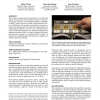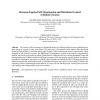1569 search results - page 5 / 314 » Using Organic Computing to Control Bunching Effects |
CMOT
2011
12 years 11 months ago
2011
Artificial Intelligence has contributed (formal) design models and software support tools to application areas such as architecture, engineering and software design. This paper exp...
ISCAS
2007
IEEE
14 years 1 months ago
2007
IEEE
—The paper presents architecture and synthesis results for an organic computing hardware for smart CMOS camera chips. The organic behavior in the chip hardware is based on distri...
CHI
2011
ACM
12 years 11 months ago
2011
ACM
We introduce dynamic physical properties as an additional degree of freedom for passive tabletop controls. Using electromagnetic actuation, we manipulate attributes of tangibles o...
EUSFLAT
2001
13 years 8 months ago
2001
This work points out advantages for the application of fuzzy logic in organization analysis and control. From the presented motivations we propose both a managerial control cycle ...
AROBOTS
2004
13 years 7 months ago
2004
The control of robot swarming in a distributed manner is a difficult problem because global behaviors must emerge as a result of many local actions. This paper uses a bio-inspired ...


